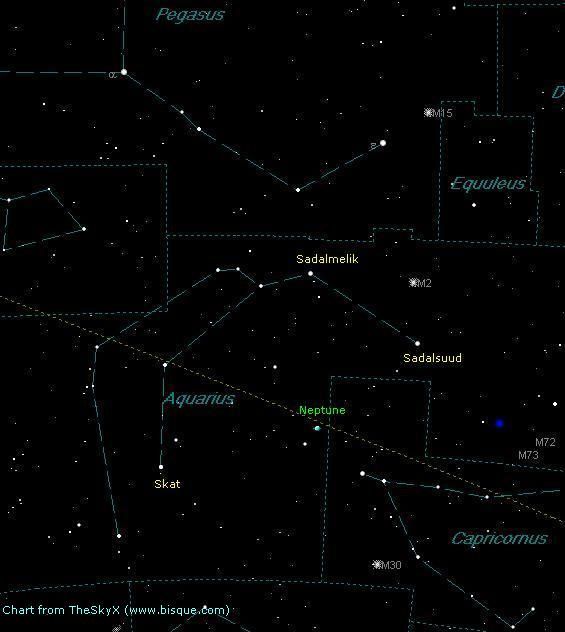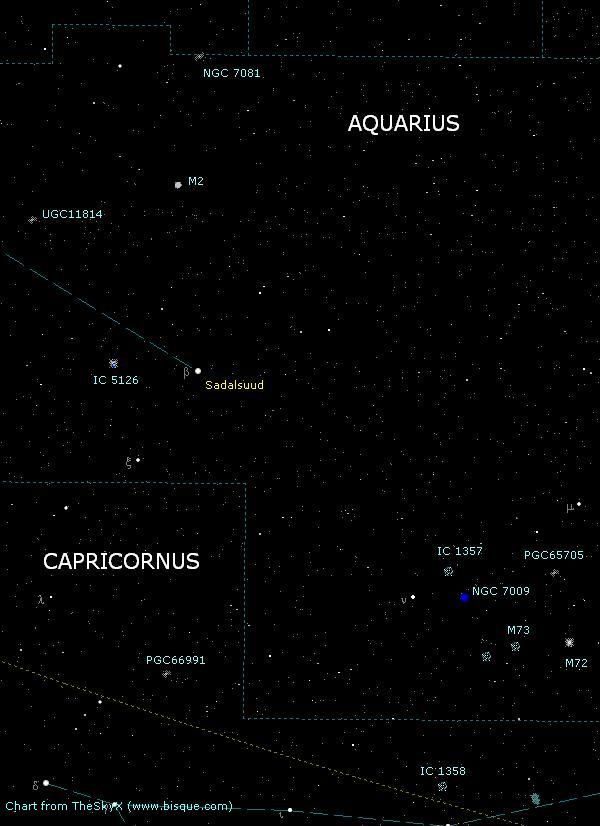Aquarius The Water Bearer
Now that we are well into fall, many factors are in a sky gazers favour. We first have about ten hours of darkness (except when the moon is out). Couple that with very low temperatures that drive away mosquitoes, as well as the absence of traditional summertime haze and humidity and we, have the possibility of memorable nights ahead. This month, we will focus on Aquarius the Water Bearer. Its overall area lists as the 10th largest (980 square degrees) and can be found between Capricorn on the right and Pisces on the left. Aquarius is located in the southern part of the night sky.
The familiar asterism consists of ten stars appearing as two side by side backward commas. The alpha star named Sadalmelik shines at magnitude 3.2. It is located some 750 light-years from us and is a yellow G type star. With luminosities some 3,000 times that of our Sun, this star is classified as a rare modest supergiant. Its enormous girth indicates it is starving for fuel and dying. This starvation causes the star to balloon out to about the orbit of Jupiter if it were in our solar system. This would not be a good thing for us. But some five billion years from now, our Sun will be following this same fate and expand to the orbit of Mars.

Sadalsuud the beta star, is located ten degrees from Sadalmelik. By coincidence, this G class supergiant star is also going through its final stages of life. It measures 50 solar diameters across (10 diameters less than Sadalmelik) and has a surface temperature of 5,800 K or the exact temperature as our Sun.
If you want to see a star that is a parent to no less than four planets and the closest to our solar system, locate Gliese 876. First, find the magnitude 3.2 star Delta Aquarii in the southern portion of the constellation’s boundary. Using the chart, Gliese 876 should be about two degrees north of this star. At only 15 light-years down the cosmic street, Gliese 876 shines at tenth magnitude and is a target for upcoming star parties or just showing off to the neighbours.
Moving back to the western section of Aquarius, relocated Sadalsuud and then move your scope about nine degrees southwest until you come across the Saturn Nebula. Designated as NGC 7009 the Saturn Nebula glows at magnitude 8.0 with a magnitude 11.5 central star. Its name comes from the somewhat resemblance of our famous ringed planet as seen almost edge-on. This stellar remains of a once-thriving star is located about 2,500 light-years from us.
Continue in the same direction for another three degrees to the small and distant M72. The cluster is estimated to be 106 light-years width with a population of about 100,000 suns. Appearing grayish in colour, M72 resides some 53,000 light-years from us and is one of the most remote globular clusters. For a challenge, try to spot a magnitude 14.3 galaxy. Catalogued as UGC 11814, this smudge only measures .9 arc minutes wide. Good luck with this one.

There are now three interstellar visitors appearing in our night skies. Comet 45P/Honda–Mrkos–Pajdušáková. This comet is presently in the southern part of Leo and is glowing at magnitude 9.1 but is moving away from us and getting fainter by the day.
Comet C/2009 P1 Garradd has been a well-placed target all summer and is now in the lower part of Hercules. As October moves on, Comet Garradd is at magnitude 8.0 and continues to brighten to its predicted brightest of 7.0 in February 2012.
And last but not least is Comet P/2006 T1 Levy. David’s comet is now in Andromeda and is presently at magnitude 11.2. Comet Levy will continue to brighten through the rest of the year and is expected to peak at magnitude 7.0 by the third of January.
The full Hunter’s Moon will occur on the 11th and will be the smallest moon of 2011 and new moon will occur on the 26th. With the moon absent, try to locate the zodiacal lights in the east before sunrise. The light is created by sunlight reflecting off interplanetary dust.
Until next month, clear skies everyone.
